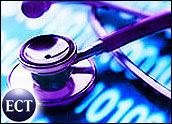
The traditional doctor’s office creates a forest of paperwork. Patient charts, records, bills: They’re all par for the course in the medical world.
Some doctors and clinics, however, are opting to go paperless, or at least almost paperless. Those who do realize numerous benefits, including greater efficiency, lower costs, and heightened security.
The trick lies in teaching the old dog of the medical profession new tricks, and not all doctors have wanted to make the switch to digital.
“There are many medical offices that are not electronic at all — they’re living in the stone age,” Juan Carlos Valls, vice president of marketing and sales for Fort Lauderdale, Fla.-based medical software company MedStar Systems, told TechNewsWorld. “I say to those doctors, ‘Wake up.’ There are many solutions that allow doctor’s offices to be more efficient.”
Storage Solutions
On the most basic level, electronic records solve one common problem in medical offices: storage. Electronic files make obsolete the walls full of paper files that clutter many doctors’ offices, and they also eliminate the costs associated with keeping such files for years.
Some medical offices choose to store these files on site, and others opt for one of the many electronic storage services offered by other companies. Phoenix-based MDS Medical Software, for instance, offers back-up or primary storage for its clients’ files, and many of them send all of their files there.
“We have clients that don’t have any information stored locally,” Terry Richardson, director of client services for MDS Medical, told TechNewsWorld.
Searching Made Simple
In addition to being easier to handle, electronic files are also more easily searchable and retrievable than paper files.
SearchExpress, for instance, is software produced by Birmingham, Ala.-based Executive Technologies that lets doctors scan documents and then search them. Character recognition is built into the software, so healthcare providers can search for a patient’s name and electronic medical record (EMR) and have the information instantly at their fingertips.
“It saves them time and money,” Jim Geer, the owner of Executive Technologies, told TechNewsWorld. “Instead of having to track down a bunch of paper documents, you can just search for them electronically.”
Both Sides Now
The fact is, healthcare offices have two major components: the administrative and the clinical. The best electronic systems are ones that digitize both sides and allow them to communicate with each other.
MedStar’s software offerings, for instance, handle both administrative and clinical tasks. On the administrative side are the calendar, scheduling, billing and other clerical and administrative tasks.
“Through automation, you’ll have almost no paper,” Valls told TechNewsWorld. “You lose all those costs associated with this work. You also lose the plain old paper costs.”
One important benefit of having the administrative side of the office go electronic is that many insurance companies now require it.
“In many cases you can’t bill anymore if you don’t do it electronically,” Valls told TechNewsWorld. “So your profitability is going to increase with electronic billing.”
On the clinical side, electronic patient records and charts can be integrated into the rest of the practice more easily.
“With electronic charts the doctor doesn’t have to worry about finding charts,” Valls told TechNewsWorld. “They have all that information at their fingertips.”
Total Support
Some companies provide end-to-end service and support for going paperless. MDS Medical Software, for example, offers not only medical software but also electronic interfaces, training, and deployment services.
“We have the most efficient deployment model in the business,” Richardson told TechNewsWorld. “We have a basic deployment model, and then we customize it to our clients’ needs.”
Richardson thinks it is vital to consider the culture of the medical profession when helping a healthcare provider to go paperless.
“Our greatest challenge is to build electronic medical records that are more in line with the culture of doctors’ offices,” Richardson told TechNewsWorld. “If we’re going to integrate systems into that culture, we have to respect it.”
To this end, MDS Medical Software focuses on training not simply doctors, but any other staff members that will have to use the electronic system.
“When we train an office to use an EMR, we don’t train a doctor as the one who does it,” Richardson told TechNewsWorld. “You’ve got to involve the whole staff. We’ve got to create systems that respect this is a total practice.”





















































